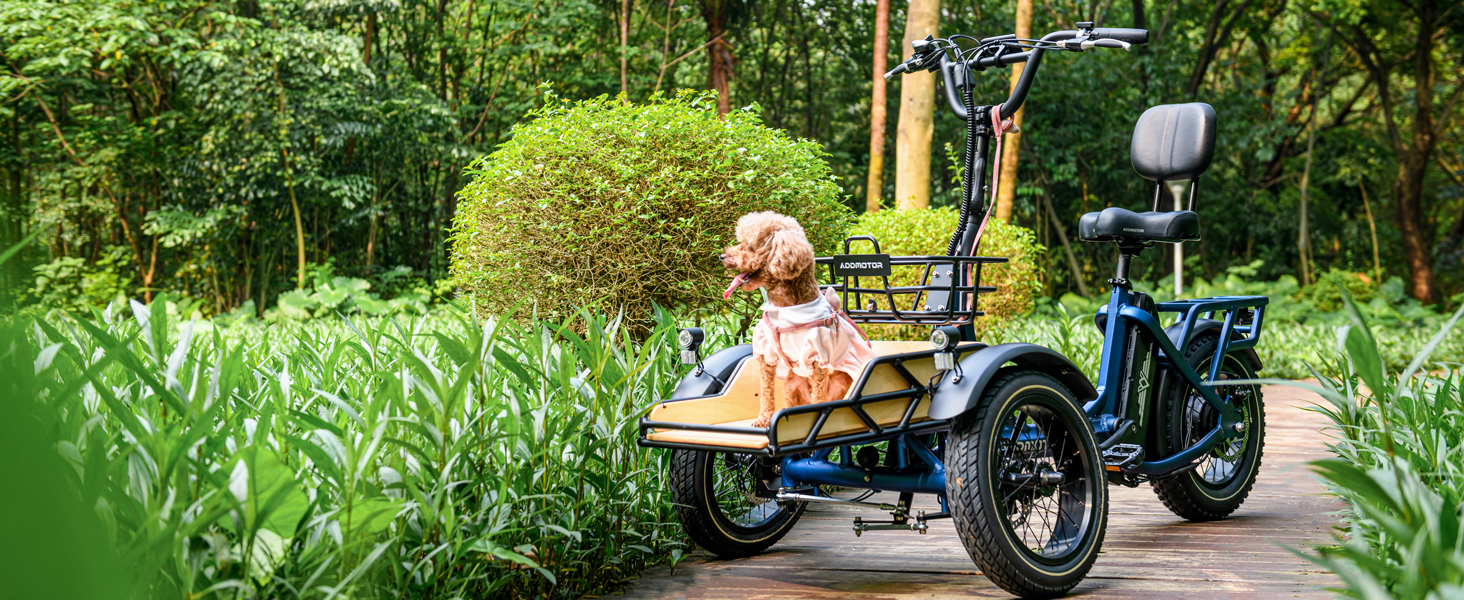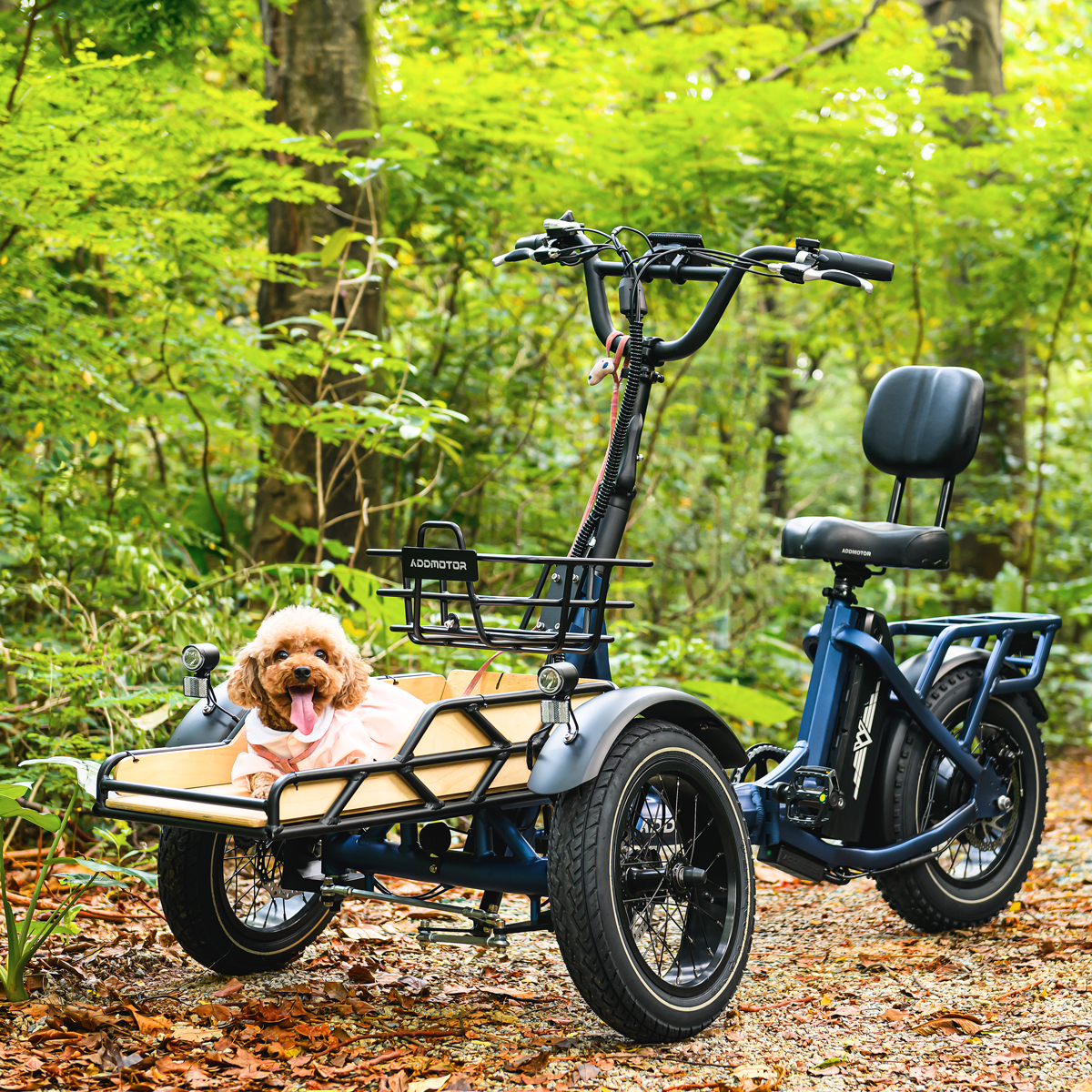What are the Main Safety Concerns with Adult Electric Trikes?
By Addmotor | 24 January 2025 | 0 Comments
Riding an electric trike might seem safer than a traditional e-bike, but that doesn’t mean accidents can’t happen.
_1739417498.webp)
In this article, we’ll dive into the key safety concerns with adult electric trikes and how to mitigate them for a worry-free experience on the road.
Staying in complete control at higher speeds can be challenging, especially when stopping or swerving suddenly.
Heavy loads in the rear rack can change your center of gravity, leading to slower acceleration or wobbliness during turns.
For one, storing your battery in very hot conditions or overcharging it can reduce its life and, in rare cases, cause fire hazards. Dropping or damaging the battery pack can also cause internal issues.
Not knowing the local laws can lead to fines, the confiscation of your trike, or more serious legal issues.
Overconfidence might lead you to take risks—like high-speed turns—without having mastered the trike’s handling. Under confidence might cause you to freeze or make sudden movements, which can also be dangerous.
Making tight turns on narrow trails on a 3-wheel electric bike can be difficult. Rocks, tree roots, and loose dirt can affect your trike’s stability.
Take the time to learn how your specific e-trike model handles turns, starts, and stops. Start slow, know your local laws, and never push beyond what you can handle comfortably. It’s better to ride defensively at the start and ensure you’re always visible and aware of other road users. Happy, safe riding!
_1739417498.webp)
In this article, we’ll dive into the key safety concerns with adult electric trikes and how to mitigate them for a worry-free experience on the road.
1. Balance and Turning
Even though an electric trike is more stable at a complete stop, turns and curves can feel different. If you take a turn too sharply or quickly, there’s a risk of tipping if the weight shifts suddenly.What to Do:
- Practice Makes Perfect: Spend time riding your electric tricycle in an empty parking lot to practice turns at low speeds. Get used to how it responds when you shift your body weight or lean.
- Adjust Your Speed: Don’t zoom through turns. Slow down, especially if you’re still getting the hang of it.
2. Speed and Acceleration
One of the biggest perks of an adult electric trike bike is that you can pedal comfortably while the motor lends a helping hand. However, if you’re not careful, you can accelerate quickly and find yourself going faster than intended.Staying in complete control at higher speeds can be challenging, especially when stopping or swerving suddenly.
What to Do:
- Use Lower Assistance Settings: Start with the lowest pedal assist setting, and only increase as you gain confidence.
- Know Your Brakes: Get a feel for how your e-trike responds when braking gradually versus quickly. Practice gentle braking and emergency stops in a safe environment to get a sense of how quickly you can come to a halt.
- Riding 2 Front Wheel Electric Trikes: When riding a 2-front-wheel electric trike, the wider front end can make it harder to navigate tight spaces and sharp turns. To maintain balance, you can add weight to the front rack. Additionally, it is recommended to reduce speed when turning to avoid rollover.


3. Weight Distribution and Cargo
An electric trike for adults may allow you to carry cargo in the rear or front basket. While this is great for errands and day trips, adding weight can affect the way your electric tricycle handles.Heavy loads in the rear rack can change your center of gravity, leading to slower acceleration or wobbliness during turns.
What to Do:
- Distribute the Load Evenly: Place heavier items as close to the center of the trike as possible. Keep your load balanced side-to-side so one side doesn’t pull the trike more.
- Go Easy on the Speed: The trike’s handling will change under a heavier load, so adjust your speed accordingly. Also, you’ll need more distance to brake.
4. Battery and Electrical Concerns
Modern lithium-ion batteries are generally safe, but improper handling or charging can cause problems.For one, storing your battery in very hot conditions or overcharging it can reduce its life and, in rare cases, cause fire hazards. Dropping or damaging the battery pack can also cause internal issues.
What to Do:
- Follow Manufacturer’s Instructions: Always charge your battery with the recommended charger and follow the guidelines in your user manual. Don’t leave it plugged in longer than necessary.
- Store in a Cool, Dry Place: If you’re not going to use your adult electric trike for an extended period, store the battery in a moderate climate away from direct sunlight.
- Regular Checks: Inspect the battery and wiring for any signs of damage or wear. If something seems off, contact the manufacturer or a professional service center.
5. Visibility to Other Road Users
Adult electric trikes may be taller than standard tricycles but lack width. They can also be lower to the ground, often with less prominent lighting, which increases the chance of collisions at intersections or driveways.What to Do:
- Use Lights and Reflectors: Most electric trike bikes for adults come with built-in lights. Make sure they’re turned on, especially in dim conditions. Add extra reflectors if necessary.
- Wear Bright Clothing: Don’t blend into the surroundings. Wearing bright or reflective gear can help others spot you sooner.
- Keep in Lane: Generally, it’s safer to ride in the bike lane so cars don’t try to squeeze past too closely. Riding on the far right of the road is the next best option.
6. Road and Weather Conditions
Even though three wheels are supposed to provide more stability than two, slippery surfaces can still cause slipping or skidding due to loss of traction.What to Do:
- Slow Down on Slippery Surfaces: Reduce your speed if it’s raining or the roads are wet. The stopping distance will be longer, and traction might be reduced.
- Be Cautious on Rough Terrain: If you see potholes, large cracks, or loose gravel, approach them slowly. Try to avoid them altogether, but if that’s not possible, go over them cautiously and in control.
- Regular Tire Checks: Make sure your tires are properly inflated. Good tire pressure helps traction and handling, especially in less-than-perfect weather conditions.
7. Rider Comfort and Posture
If you’re not seated properly or your electric tricycle’s seat or handlebars are in the wrong position, you may experience fatigue, discomfort, slower reaction times, and potential mistakes while riding.What to Do:
- Proper Fitting: Adjust the seat height and handlebar position so you’re comfortable and not straining your back, arms, or neck.
- Take Breaks on Longer Rides: If you’re going for a longer trip, schedule shortstops. Stretch your legs, hydrate, and give your eyes a rest.
- Invest in a Good Seat: Many electric trike bikes for adults come with comfortable seats, but if you need more cushioning or support, consider upgrading to a custom seat.
8. Following Local Laws and Regulations
Rules for electric adult trikes can vary from place to place. Some areas treat them like bicycles, while others may have separate requirements regarding speed limits, where you can ride, and how the trike is classified.Not knowing the local laws can lead to fines, the confiscation of your trike, or more serious legal issues.
What to Do:
- Do Your Research: Check your local Department of Motor Vehicles (DMV) or equivalent authority to understand the rules around 3-wheel electric bikes.
- Stay Updated: Laws can change, especially as electric tricycles become more popular. Periodically check for any new regulations.
- Carry Identification and Necessary Documents: If your area requires registration or a license for an e-trike, have those documents on you when you ride.
9. Protective Gear
Some riders assume they don’t need protective gear because they’re on a more stable, three-wheeled vehicle. But falling off a trike or a collision at moderate or higher speeds can cause head trauma, scrapes, or serious injuries if you’re not protected.What to Do:
- Wear a Helmet: Make sure you wear a helmet that fits well and meets safety standards.
- Consider Additional Protection: Knee and elbow pads may be helpful if riding on rough terrain or at higher speeds.
- Choose the Right Footwear: Closed-toe shoes that stay securely on your feet can prevent foot injuries.
10. Building Confidence and Awareness
As with any vehicle, mastering the finer points of steering, balance, and power assist on an electric trike takes time. With time comes confidence in predicting and responding to situations more effectively.Overconfidence might lead you to take risks—like high-speed turns—without having mastered the trike’s handling. Under confidence might cause you to freeze or make sudden movements, which can also be dangerous.
What to Do:
- Start Slow and Gradually Increase Difficulty: Begin on quiet streets or trails with minimal traffic. As you gain experience, venture into areas with more cars or pedestrians.
- Take a Friend Along: Riding with someone more experienced, or even just having a companion, can help you feel safer. They can also give you tips on riding and help in an emergency.
- Stay Alert: Avoid distractions like texting or talking on the phone while riding. Your full attention should be on the road and surrounding conditions.
11. Navigating Different Terrains
Some electric trike models are designed for light off-road adventures, but venturing off paved roads presents some challenges.Making tight turns on narrow trails on a 3-wheel electric bike can be difficult. Rocks, tree roots, and loose dirt can affect your trike’s stability.
What to Do:
- Pick Appropriate Routes: Start with well-maintained paths if you’re new to riding off-road. Make sure your electric tricycle is designed for tougher terrain, and you have enough riding experience.
- Shift Your Weight: On uneven ground, shifting your weight to keep the trike balanced can help. Practice this on gentle trails first.
- Watch Out for Obstacles: Look ahead and slow down if you see large rocks or holes.
Final Words
Riding an electric trike for adults can be an incredibly freeing experience. However, safety should always come first.Take the time to learn how your specific e-trike model handles turns, starts, and stops. Start slow, know your local laws, and never push beyond what you can handle comfortably. It’s better to ride defensively at the start and ensure you’re always visible and aware of other road users. Happy, safe riding!
Leave a Reply
Your email address will not be published.Required fields are marked. *
Latest Stories

_1744104620.webp)

_1745477523.webp)
_1745224738.webp)